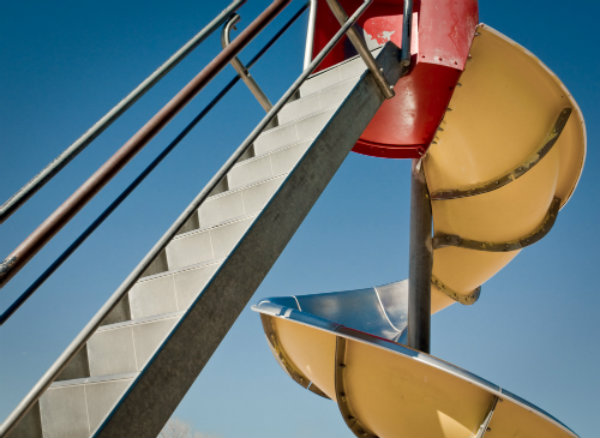
You may recall days when playgrounds had towering rocket ships and wavy, burn-your-butt slides made of metal.
Some of those old structures still stand in schoolyards and playgrounds. But for the most part, they’re being edged out by equipment that’s thought to be safer – molded plastic play structures sitting on cushiony surfaces.
Manitou Springs photographer Brenda Biondo gets nostalgic for the structures of playtime past in her new book, “Once Upon a Playground: A Celebration of Classic American Playgrounds, 1920-1975.”
The book features photos of splintery see-saws made of wood; dizzying, multi-colored merry-go-rounds; swings supported by chains and myriad other types of old equipment, some of it rusting away.
In her years shooting photos for the book, Biondo noticed vintage playgrounds around America disappearing.
“I’d say probably half the equipment has been taken down since I took photographs of it,” she says.
Modern playgrounds began popping up more than a century ago, in part because of the efforts of children's advocates who sought to curb juvenile delinquency and instill good values.
“They started these playgrounds as a way to get kids off very dangerous streets, where they’re very often getting hurt, but also they’re also getting into trouble,” Biondo says. “They were bored, they were running around, they were stealing things.”
Biondo’s book includes many catalog images for playground structures and equipment, along with the sales pitches that were made to parks and schools. One image shows the Eureka Studebaker Park Combination from the 1920s, a series of ladders, platforms, slides, bars and rings. Under the drawing of the equipment, it states: “Better the playground and trained leaders than reformatories and uniformed guards.”
By the early 1900s, building playgrounds was a definite movement in the United States, perpetuated with the support of President Teddy Roosevelt, who championed kids’ “birthright” to play.
In Pueblo, Colo., R.F. Lamar & Co. built a line of playground equipment in the 1930s called “Karymor,” including sets with rings and a precursor to the merry-go-round. Biondo found some of the company’s items still standing in playgrounds, including in Denver at the Del Pueblo Elementary School, located near the Art District on Santa Fe.
One reason the old play structures are disappearing is because of new safety standards. Biondo notes research that shows children were injured about 20 percent less often on playgrounds in 2012 than in 1980, when the old equipment was still widely used. However, she also cites a study that indicates children are good at gauging risks.
She laments the disappearance of the old structures, which she views as a form of interactive art.
"Manufacturers and park departments and cities got so concerned about being sued – liability – that the pendulum kind of swung a little bit too far to the other extreme," Biondo says, "so that things became so safe and so boring that they weren’t holding the interest of kids as much."








